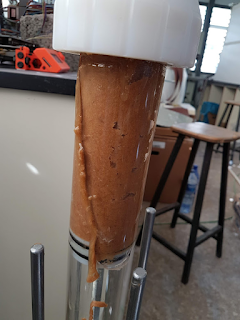Too much pressure
A local company built a ram extruder for us. Not very different from a syringe extruder but massive in terms of size and pressure.
Our assumption was that parts had been sized properly, so we did not question the 8.7Nm NEMA34 stepper, nor the 5mm-thick acrylic tube with a 60mm internal diameter. After all, it was not the first time they have built a similar contraption to be used with clay.
Unfortunately, though we try to be very gentle on the extrusion test, we manage to break the tube in a few minutes. Luckily for us, it cracked without sending debris around. We did not expect that at all and when we contacted the seller all sorts of questions were asked, questions we did not have an answer for, like "what was the operating pressure?". I did not have a clue as I was just trying to get the stepper rotating very slowly. Their diagnose was we did it wrong as we set the nominal current (6A) for the stepper driver.
In our case, and assuming no friction loses happen anywhere, the mechanical advantage of a threaded rod can be calculated by 2Πr/lead. We are using a 2mm lead screw, every turn the nut moves 2mm in the axial direction. And that mechanical advantage can be expressed as the relationships between output and input forces or, as is our case, the output force, and the input torque.
So the force of the nut moving forward when turning the threaded rod with 8.7 Nm is the torque times the mechanical advantage. In our case, 8.7*2*Π/0.002=8700*Π=27331 N which definitely seems like a lot of force.
Given the surface of the cross-section of the tube is 30^2*Π=2872 mm^2, then the maximum achievable pressure would be P=F/S=27331/2872=9.5 N/mm^2=9.5 MPa and as 1 MPa = 10 bar, the achievable maximum pressure would be 95 bar, which is a significant value.
Unfortunately, a quick view of the pressure a plexiglass tube can handle shows that for our tube is only 3.1 bar or 60 times less than what the mechanical system can deliver. No wonder we broke it.
Of course, if taking into account friction losses the actual achievable pressure would be way below the value above. Efficiencies around 15-25% can be expected so maximum pressure could be between 15 and 23 bar.
Our assumption was that parts had been sized properly, so we did not question the 8.7Nm NEMA34 stepper, nor the 5mm-thick acrylic tube with a 60mm internal diameter. After all, it was not the first time they have built a similar contraption to be used with clay.
Unfortunately, though we try to be very gentle on the extrusion test, we manage to break the tube in a few minutes. Luckily for us, it cracked without sending debris around. We did not expect that at all and when we contacted the seller all sorts of questions were asked, questions we did not have an answer for, like "what was the operating pressure?". I did not have a clue as I was just trying to get the stepper rotating very slowly. Their diagnose was we did it wrong as we set the nominal current (6A) for the stepper driver.
From torque to pressure
So I was determined to figure out how the hell you can know the pressure a similar contraption can produce when using a given motor. Data input had to start from the motor torque and the physical dimensions of the piston.In our case, and assuming no friction loses happen anywhere, the mechanical advantage of a threaded rod can be calculated by 2Πr/lead. We are using a 2mm lead screw, every turn the nut moves 2mm in the axial direction. And that mechanical advantage can be expressed as the relationships between output and input forces or, as is our case, the output force, and the input torque.
So the force of the nut moving forward when turning the threaded rod with 8.7 Nm is the torque times the mechanical advantage. In our case, 8.7*2*Π/0.002=8700*Π=27331 N which definitely seems like a lot of force.
Given the surface of the cross-section of the tube is 30^2*Π=2872 mm^2, then the maximum achievable pressure would be P=F/S=27331/2872=9.5 N/mm^2=9.5 MPa and as 1 MPa = 10 bar, the achievable maximum pressure would be 95 bar, which is a significant value.
Unfortunately, a quick view of the pressure a plexiglass tube can handle shows that for our tube is only 3.1 bar or 60 times less than what the mechanical system can deliver. No wonder we broke it.
Of course, if taking into account friction losses the actual achievable pressure would be way below the value above. Efficiencies around 15-25% can be expected so maximum pressure could be between 15 and 23 bar.




Comments